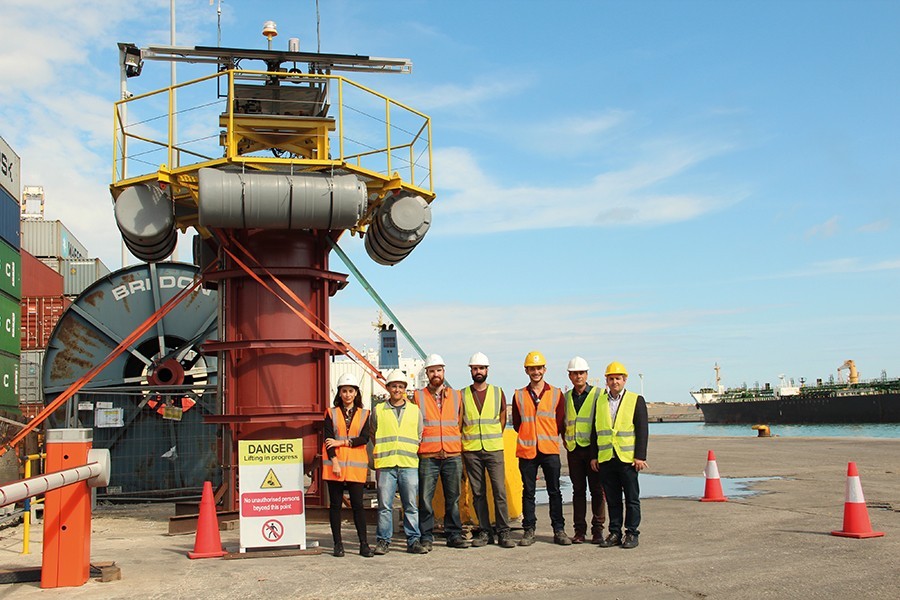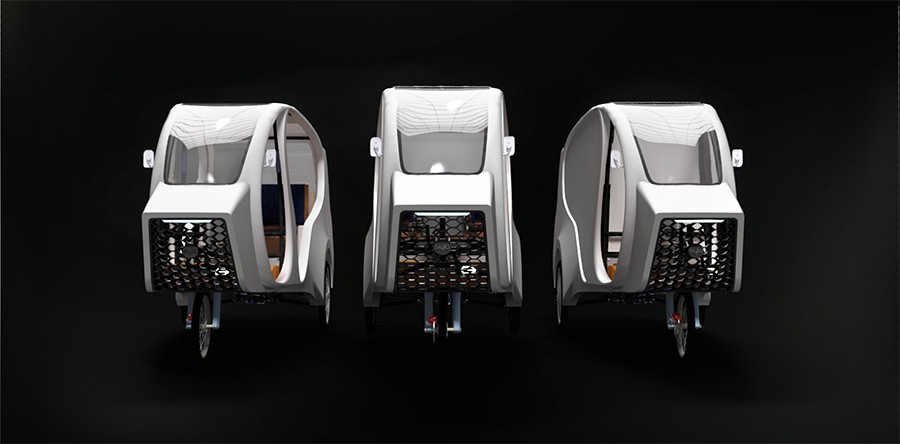In the first weeks of November, the world came together for the 26th United Nations Climate Change Conference, an event researchers across the globe are calling ‘the world’s best last chance to get runaway climate change under control’. During this two-week conference, one of the aims was to put forward proposals to ‘secure global net zero by mid-century and keep 1.5 degrees within reach’, which will involve phasing out coal use around the world and putting more resources into sustainable energy methods. One such method that is being touted as a groundbreaking solution is nuclear fusion. THINK magazine sat down with Prof. Ing. Pierluigi Mollicone and Prof. Ing. Martin Muscat, associate professors at the Department of Mechanical Engineering at the University of Malta, to learn more about what nuclear fusion is all about.
Continue readingTaking solar to sea
In a world first, a small team of engineers at the University of Malta is attempting to prove that harnessing solar power in the open sea is theoretically possible and cost-effective. Laura Bonnici speaks to Prof. Luciano Mulѐ Stagno to learn more about the ground-breaking Solaqua 2.1 project.
Renewable energy is in the spotlight. In Malta—an island that is said to enjoy an average of 300 days of sunshine per year—solar power has become mainstream, enabling the country to reach its goal of using 10% renewable energy by 2020.
But any advantage Malta has in terms of abundant sunshine, it loses through its lack of another vital resource: space. Measuring just 316 km², Malta’s limited surface area means that, beyond the existing photovoltaic (PV) panels installed on rooftops or disused quarries, any land left for larger PV installations is rare and expensive.

Prof. Luciano Mulѐ Stagno at the University of Malta believes the answer to this problem lies not on land, but at sea. Malta being surrounded by water, he has proposed that installing solar panels in open water, in offshore floating PV farms, could be as cost-effective and reliable as those on land—an idea that has never progressed beyond the theoretical stage anywhere in the world.
‘There are many PV projects happening on fresh water everywhere, from China and the UK to France and USA. But none of them are working on open sea,’ explains Mulѐ Stagno. ‘Their PV farms are installed in more sheltered, land-locked waters such as irrigation ponds or lakes, believing that PV farms cannot survive sea conditions. The Solaqua project aims to prove that they can survive, and do so at a comparable cost to land-based PV farms.’
When funding was secured from MCST in 2012, the previous Solaqua 1.0 project set about achieving these ambitious aims. Testing various prototypes out at sea, it confirmed that large, floating platforms were viable, cheap to construct, and could produce more power than similar systems on land.
The sea proved beneficial for many reasons. ‘The offshore panels produced around 3% more energy than similar land-based modules simply by being at sea, possibly due to the cooler temperatures at sea and a less dusty environment.’
The success of the first project inspired a second. With this one, the modular raft was designed and tested. ‘Solaqua 2.0 was financed by Takeoff [The University of Malta’s business incubator] in July 2017, with a preliminary design for the platform almost completed. Now discussions are underway about possible patents for the design,’ Mulѐ Stagno elaborates. ‘The ultimate aim is to launch a large farm in Maltese territorial water which, if it meets

the cost and power output targets, will be followed by other systems worldwide.’
The Professor and his team (marine structural engineer Dr Federica Strati, systems engineer Ing. Ryan Bugeja, and engineer Martin Grech) are now starting the next phase of the Solaqua project. Before the team builds and launches a full-scale system, they have to conduct a series of rigorous wave tank tests. Using a scale model while mimicking the worst possible sea conditions that the system may encounter, the team will be able to refine the design and optimise power output by testing the effect of water motion, cooling, or even different types of panels.
‘Through Solaqua 2.1, we hope to reassure investors that the system is viable. Once completed, we will be ready to launch a full-scale system that could be used not only by islands such as Malta, but also in coastal cities around the world which have insufficient land available for PV systems.’
Investors are being invited to join this project to push for global commercialisation. To reach this stage, several local entities supported the project. The Regulator for Energy and Water Services, with the help of the RIDT (the University of Malta’s Research Trust), invested €100,000 to cover the cost of constructing the scale model, as well as testing, equipment, transport, and engineers. And now that the project is commanding international interest, potential investors are being sought for the half a million euros needed to achieve a full-scale floating solar farm in Maltese waters.
‘This is a homegrown project, in which Malta could be an example to the world,’ explains Mulѐ Stagno. ‘We have already placed Malta at the cutting edge of this research area by being the first to test small systems in the open sea. Now we need to find an investor willing to take the plunge and help us create the world’s first full-scale floating solar farm. With Solaqua, Malta could be at the forefront of a ground-breaking new global industry—one which has the potential to change the way solar power is collected and used the world over.’
Green heat, green power
At face value, renewable energy seems the smartest choice for a cleaner tomorrow. But when green energy cannot be stored, what do we do during scorching summer afternoons and cold winter nights? Cassi Camilleri speaks to Prof. Joseph Cilia and his team to find out more about the innovative solution they are developing.
The movement towards sustainability has been ramping up over decades. Now, it feels like it has reached fever pitch. Headlines are hogged by the latest scary statistic on air, land, or sea pollution. People are rallying, demanding that new measures be implemented to reduce waste and clean up our streets. Despite this call, real advances on these issues always manage to find themselves obstructed by seemingly ‘rational’ arguments.
For one, renewable energy isn’t as reliable and cheap as fossil fuels. Overhauling the status quo is expensive and requires significant effort, both of which make people frown. Solar power depends on the sun, wind power depends on wind, both of which are quite unpredictable. But while this is true, it shouldn’t even be considered an issue. We live in a country on the receiving end of 550,000 GWh of solar energy annually, while we need only 3,484 GWh to cover all energy consumption. Let that sink in.
Of course, I hear your concerns about the quantity of solar panels needed to harvest that energy—Malta is so small and built up. But in reality, only 28% of our island is built up, and just 7% of the remaining land would be required to meet the total energy demand. So yes. There are solutions to our energy woes. And those solutions need to be combined to create the best results.
Thanks to support from Abertax Kemtronics and MCST (Malta Council for Science and Technology), Prof. Joseph Cilia and his team of researchers (Department of Industrial Electrical Power Conversion, University of Malta [UM]) have found that houses with a normal-sized photovoltaic system can supply more than 100% of the total energy they need during summer. During winter, that figure falls to 50%. To manage this drop, energy can be supplied through other sources. Enter the Micro-CHP.
A small combined heat and power (CHP) machine provides seasonal energy in two forms: electrical and thermal. It consists of a standard internal combustion engine coupled with a generator that produces electrical energy. The thermal energy resulting from the engine and exhaust is then recovered using water heat exchangers and reused to heat the house and domestic water.
While similar systems already exist, most are geared towards industrial applications. The rest cost, on average, around €15,000—pricing a large cross-section of society out. The system Cilia and his team have developed makes use of a grid PV system, combined with battery energy storage, a heating and cooling heat pump load, a CHP machine, and LED lighting. It is also an easy-to-install, plug-and-play solution that fits into your current setup, as opposed to a complex installation that would force everything to change with it. By the end of it, the team’s CHP will cost the consumer around €8,000.
Their study of Maltese households showed that in a typical medium-sized household, energy needs vary substantially. The energy fluctuations for a typical Maltese household are usually about 500 kWhr between the summer and winter seasons. In this case, storing this energy in a battery is not feasible. What is feasible is simply making more efficient use of the LPG gas tank that most people already have and use at home. If one wants to be renewable, one can also use ethanol or methanol to operate the CHP, which, if used in combination with a heat pump, can easily reach an efficiency of 150% to 180% in heating mode.
Added to this, the team’s system is unique compared to others on the market. It is connected directly to the main electricity supply, tapping into it whenever the system needs support, while not using mains electricity when enough energy is being produced by the system itself.
The system is scalable due to the plug-and-play concept the system is based on. It can be upgraded as more and more savings are made on electricity bills. ‘The idea is to provide a cost-effective solution that even low-income households can afford,’ says Cilia. This can not only trigger a widespread use of energy generation and storage for domestic use, but also turn consumers into suppliers of their own energy needs. Gone are the days of being dependent on the grid.
Author: Cassi Camilleri
Project A Smart Micro Combined Heat and Power System financed by the Malta Council for Science & Technology, for and on behalf of the Foundation for Science and Technology, through the FUSION: R&I Technology Development Programme.
Cool batteries are good batteries
As consumers, we are all-too-familiar with the daily chore of charging our smartphones or tablet. With increasing emphasis on greener technologies such as electric vehicles and renewable energy generation, battery technology becomes more important. Words by Dr Robert Camilleri.
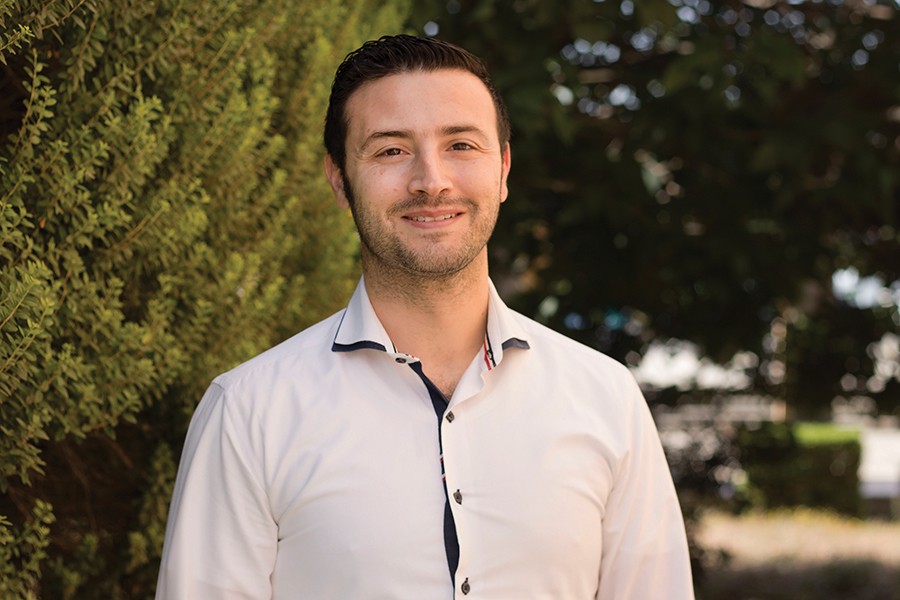
As consumers, we are all-too-familiar with the daily chore of charging our smartphones or tablet. With increasing emphasis on greener technologies such as electric vehicles and renewable energy generation, battery technology becomes more important.
Classic lithium-ion (Li-ion) batteries are currently the most common, storing energy in chemical form. The problem with these is their temperature sensitivity. During repeated cycles of charging and discharging, the chemical reaction that drives the battery creates heat which affects its storage capacity and lifetime. Not only that, but these high temperatures present a real health and safety concern. Thermal runaway, where a battery creates a vicious cycle of heat generation, can lead to catastrophic failure. Remember the Galaxy Note 7 explosions? So how can we cool batteries down?
Keeping things chill
While a number of studies have attempted to apply traditional cooling (such as the air cooling in the laptop I’m using to write this article) to batteries, this was found to be inefficient for high-performance battery packs. As air passes over the battery cells, it gradually warms up and its effectiveness cooling subsequent batteries deteriorates, leaving battery cells in the same pack operating at different temperatures. The battery cell with the highest temperature becomes the weakest link.
The need to have a fast charging mechanism, especially when it comes to consumer products, is real.
High temperatures limit dis/charging rates and energy storage capacity, causing batteries to degrade faster, dictating the life of the pack. While attempts to use liquid cooling proved to be more efficient than air cooling, they still did not solve the issue. To counter this problem, the industry has developed complex and expensive electronic battery management systems that monitor the temperature of each cell and adjust the charging rate. But again, while this protects the cells, it limits the current flow during discharging, causing long waiting times in between battery use. The need to have a fast charging mechanism, especially when it comes to consumer products, is real. Battery-powered electric vehicles, for example, are much more likely to be accepted if a fast charging mechanism is introduced. This would make them comparable with regular cars that need to be taken to traditional petrol stations for fuel.
A different approach
Our project NEVAC (short for Novel EVAporative Cooled battery technology) solves this problem with a novel cooling strategy. With NEVAC, we want to keep the entire battery pack at a uniform temperature. We’re using a liquid coolant with a low boiling point which absorbs latent heat as battery cells warm up. When the coolant reaches its boiling point, it evaporates and turns into gas. The gas travels to a cooler part of the battery pack, lets off the heat it has absorbed into the ambient environment, and condenses back to liquid, closing the loop of this self-sustained cooling cycle. As the coolant within the entire battery pack boils at a single temperature, all the battery cells within the pack are kept at one uniform temperature.
NEVAC is currently developing an experimental proof of concept of this technology with Abertax, our industrial partner. Following a proof of concept, the project will be scaled up with the prospect of developing the technology for the market. It will show how an improved battery cooling technology will lead to higher battery storage capacity, longer battery life, and better dis/charging rates. That daily chore of charging your smartphone for more than a few minutes could soon be forgotten.
The research is led by Dr Robert Camilleri (University of Malta), in collaboration with industrial partner Abertax Kemtroniks. Project NEVAC is funded by the Malta Council for Science and Technology Fusion: The R&I Technology Development Programme 2017.
Read more:
Selyukh, A., As Batteries Keep Catching Fire, U.S. Safety Agency Prepares For Change, retrieved on 30th March 2017
https://n.pr/2fBZsfJ
Author: Robert Camilleri
Reliable renewables need storage
Renewable resources cannot be implemented if the energy they generate cannot be stored. Daniel Buhagiar explains the solution they’re cooking up at the University of Malta.
Igniting a sun on Earth
The Sun is the most important source of energy for life on Earth. Powerful as it is, what would happen if humankind could create a miniature sun in a lab and harness its energy? This is the mission of Dr Ing. Nicholas Sammut, Dr Ing. Andrew Sammut, and Karl Buhagiar.
Harnessing the power of the sun
Malta is not a resource rich country, but in the shift towards renewable energies, our sunshine is now coveted for more than just tanning. Hans-Joachim Sonntag talks to Prof. Luciano Mulè Stagno about his experience in improving solar panel materials and building a research facility from scratch.
Continue reading
A Green Future for Electrical Networks
Malta can lead EU countries to become the first green island in the Mediterranean with 100% renewable energy. Dr Alexander Micallef, Prof Ing. Cyril Spiteri Staines and Prof. Maurice Apap tell us more about how Malta could do it.
Sylo
Function, form, safety, and environment. SYLO is a family of hybrid cycle rickshaws that fulfils all four design pillars to deliver good performance and a smooth ride. SYLO is designed for short distances, catering to commuters and delivery services. What sets it apart from its counterparts is its mixed-propulsion technology, using both photovoltaic panels and pedal power. Adding to its ‘green’ points is the fact that recyclable plastics have been used for the body. This helped from an engineering perspective because it kept the vehicle light, allowing it to serve its function despite the difficult terrain it must operate in.
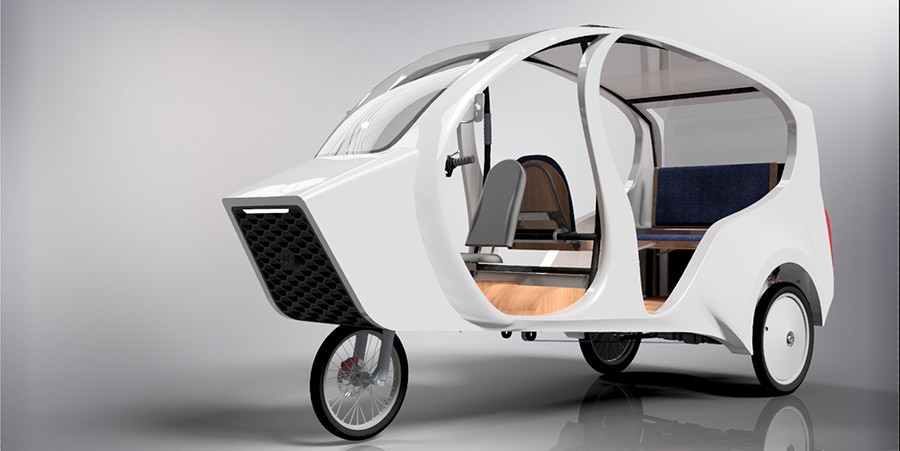
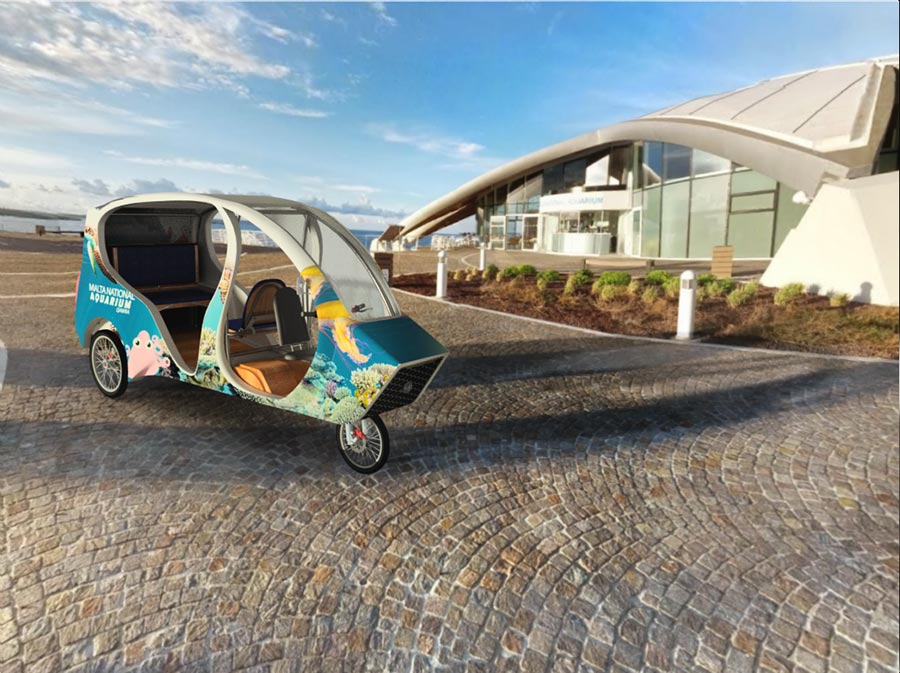
What sets it apart from its counterparts is its mixed-propulsion technology, using both photovoltaic panels and pedal power.
Form was an especially important factor in the design process. As the aim was to use this vehicle both within the historical context of the capital city, Valleta, and in cosmopolitan spaces such as Paceville and Bugibba, it was essential for the vehicle to complement its built environment, be it classical or contemporary. Towards this end, bold lines were used, making the vehicle look distinct without looking alien.
SYLO was the product of 10 mechanical engineering students supervised by academics from the Department of Industrial and Manufacturing Engineering, Faculty of Engineering, University of Malta as part of a third-year engineering design project.
Extreme stars unlock gravitational secrets
Our understanding of gravity has changed over the years and will likely continue to as researchers arm themselves with new ideas tested by increasingly sophisticated technology. Dr Jackson Levi Said, Mark Pace, and Filippos Nachmias (University of Malta [UoM]) tell THINK more about their mission to unlock gravity’s secrets from neutron stars.





